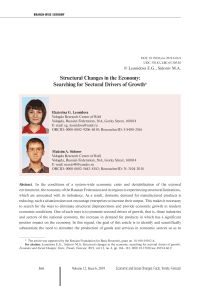Structural changes in the economy: searching for sectoral drivers of growth
Автор: Leonidova Ekaterina G., Sidorov Maksim A.
Журнал: Economic and Social Changes: Facts, Trends, Forecast @volnc-esc-en
Рубрика: Branch-wise economy
Статья в выпуске: 6 (66) т.12, 2019 года.
Бесплатный доступ
In the conditions of a system-wide economic crisis and destabilization of the external environment, the economy of the Russian Federation and its regions is experiencing structural limitations, which are associated with its imbalance. As a result, domestic demand for manufactured products is reducing; such a situation does not encourage enterprises to increase their output. This makes it necessary to search for the ways to eliminate structural disproportions and provide economic growth in modern economic conditions. One of such ways is to promote sectoral drivers of growth, that is, those industries and sectors of the national economy, the increase in demand for products in which has a significant positive impact on the economy. In this regard, the goal of this article is to identify and scientifically substantiate the need to stimulate the production of goods and services in economic sectors so as to promote structural changes in the economy at the national and regional levels. In this study, we consider mechanical engineering, information and communication technologies and tourism as drivers, which have a large multiplier effect and contribute to economic growth. The article assesses the consequences of stimulating the selected sectors of the economy in the context of structural changes both at the nationwide level and in the territorial context; this provision forms the scientific novelty of the study. The findings of the study reveal problems in development of mechanical engineering, information and communication technologies and tourism, confirm the importance of their development for the economy; the importance is expressed in a significant increase in the main economic indicators due to the increase in the production of goods and services. We use general scientific methods such as analysis, synthesis, comparison, generalization, and the tools based on the input-output methodology. In the future, we plan to continue our work aimed at determining the correspondence of the parameters of development of these sectors contained in the strategic documents and the results obtained in the study for a deeper understanding of the problems of structural adjustment of the economy.
Structural changes, economy, economic growth, engineering, ict sector, tourism
Короткий адрес: https://sciup.org/147224229
IDR: 147224229 | УДК: 338.45 | DOI: 10.15838/esc.2019.6.66.9
Текст научной статьи Structural changes in the economy: searching for sectoral drivers of growth
Introduction. The economy of Russia and its regions is characterized by a slowdown in growth, a reduction in domestic consumer demand, household income, the dominance of the fuel and energy sector to the detriment of the development of high-tech industries, which brings to the fore the issue of structural transformations. Studies show that “... for 2009–2017, the average annual growth rate of gross domestic product in Russia was only 0.7%; one of the reasons for such a situation is the structure of the Russian economy that does not meet modern realities” [1].
The forecasts of Russian economists regarding the prospects for economic modernization of the country in 2019 and 2020 do not seem optimistic: experts, including analysts from the Center for Structural Research of RANEPA1, the Institute “Center for Develop- ment” of NRU “Higher School of Economics”2, Gaidar Institute of Economic Policy [2], agree that economic growth is not expected in the near future. This actualizes the need to develop directions to change the current situation, especially in connection with the task Russia has to fulfill – to enter the top five economies in the world by 2024, ensuring economic growth rates above the world average while maintaining macroeconomic stability3. Scientists note that currently achieving economic growth in the country is possible on the basis of promoting consumption, in particular, the growth of domestic consumer demand and investment policy [3; 4]. In this regard, there is a need to identify and scientifically substantiate sectoral drivers of growth, since the increase in demand for their products provides structural changes in the economy.
Scientific works on the topic are dominated by the point of view of the key role of the manufacturing industry as a driver of economic growth [5]. Meanwhile, according to recent studies, the effectiveness of structural policy should be associated with the expansion of the list of directions for its implementation, which implies the creation of conditions for the development of new sectors, as well as the types of activities aimed at overcoming single-industry structure [6]. E.B. Lenchuk, Doc.Sci. (Econ.), Director of RAS Institute of Economics, points out that “searching for new drivers of economic growth is the strategic challenge for Russia...” [7, pp. 173-189].
Modern economic policy does not fully use the potential of such industries as engineering, tourism and information and communication technologies (ICT)4, whose contribution to the formation of the tax base, promotion of employment and economic activity is quite high.
One of the reasons for this situation is the lack of information about the multiplicative effects obtained from the development of these sectors; thus, the authorities do not regard them as highly profitable and promising in terms of the possibility of changing the existing structural proportions.
Meanwhile, the development of these industries to ensure structural changes in the economy is of sufficient importance. Thus, researchers have found that the development of mechanical engineering creates prerequisites for increasing the growth rate of gross regional product (GRP) to 7–8% per year and for improving socio-economic indicators in regions of the Russian Federation [8].
The ICT sector remains undervalued in terms of providing potential multiplier effects. According to expert calculations, its contribution to the Russian economy is only 3% of GDP against 6–7% in developed countries [9]. At the same time, it has a great potential for growth, which is due to the growing demand for its services from the state, business and the population.
The prospects for the development of tourism in Russia are due to the presence of unique tourist resources and demand among the population for quality recreation. Currently, a number of systemic problems in the tourism sector prevent its noticeable impact on structural transformations. Although it is obvious that the effect on the economy from its development can be felt in a fairly short time and with relatively small investments: according to various estimates, tourism has an impact on 32-53 related industries.
Thus, the scientific hypothesis of our study is formed by the idea that the promotion of such industries as engineering, ICT and tourism stimulates consumer demand, providing an increase in indicators for all types of economic activity, ensuring the growth of the economy of the country and its regions.
In this regard, the goal of the article is to identify and scientifically substantiate the need to stimulate sectoral drivers of economic growth, the development of which contributes to structural changes in the economy at the national and regional levels. The achievement of the goal of the study requires solving the following tasks: to assess the operation and identify main barriers to the development of the considered sectors; to evaluate the effects of their stimulation on the basis of input-output models; to identify the spatial distribution of these effects; to substantiate proposals for the promotion of development of these industries.
Theoretical aspects of the study . Scientific papers pay more and more attention to the issues of structural transformations of the economy; this fact confirms the relevance of research on such problems [1; 3; 4; 6; 10-18]. Scientists offer various options for changing the situation. Structural reforms can include stimulation of domestic demand and expansion of the industrial base [12]. Optimization of the economic structure is also facilitated by identifying promising industries that are able to smooth out the existing imbalances. It is noted that the structural policy for developing countries consists in searching for industries that can become drivers of growth [13].
Thus, according to scientists from RAS Institute of Economic Forecasting, it is necessary to note that in this case the goal of the structural policy is not the increase/decrease of the share of any industry in the structure of production, but “development of a functional structure of the economy, which provides the dynamics of sustainable economic growth by addressing key imbalances of demand, production and performance parameters, reducing the excessive burden on the individual sectoral complexes in the functioning of compensation mechanisms” [14, pp. 21-22].
The researchers emphasize that the structural economic policy should take into account the regional conditions of its implementation [18] and the availability of adequate statistical and analytical tools for its assessment [1].
An important direction in determining the sectors – potential drivers of growth – is to assess the effect their stimulation exerts on the economy. One of the latest works on this issue is a study by experts from the Institute of Economics and Industrial Engineering,
Siberian Branch of RAS [19], which determines the impact of national projects on the dynamics of macroeconomic and sectoral indicators of the Russian economy in 2019– 2024 on the basis of a dynamic input-output model. Since the search for driver industries, the activation of which changes the structural proportions of the economy, and the definition of the consequences for the economy from their stimulation are not exhaustive, we continue to work in this direction, using input-output modeling.
The novelty of the results consists in the development of a methodology and improvement of tools for the use of inputoutput balance in order to assess the impact of stimulating demand for products of such industries as engineering, ICT and tourism on the economy at the national and regional levels in the context of structural changes; this distinguishes our study from similar works of other scientists.
Research methods. We used general scientific methods such as analysis, synthesis, comparison, and generalization to assess the functioning and identify key barriers to the development of the industries under consideration, and to substantiate proposals for their activation. In order to substantiate the hypothesis about the impact of stimulation of these industries on the economy of the country and its regions, we used input-output method, which makes it possible to conduct scenariobased input-output modeling of the economy.
As a forecasting tool we use an input-output model that contains the types of activities “mechanical engineering”, “information and communication technologies” and “tourism”, which are not presented separately in Russian statistics. We calculated tourist output and tourist added value using the methodological tools presented in [20].
We allocated these sectors on the basis of aggregation of data characterizing the shipment of goods, performance of works and provision of services by Russian enterprises in 2017, containing an expanded list of industries related to a particular type of activity.
The model is based on the basic equation of input-output balance, which in matrix form has the form:
x = Аx + y , (1)
where x is the vector of total output; A is the matrix of direct cost coefficients; and y is the vector of the final product.
The following equation was used in the modeling:
( E – A) -1 · y = x , (2)
where E is the unit matrix; ( E – A) -1is the matrix of total cost coefficients.
Based on the obtained matrix dependence, it is possible to calculate what should be the volume of sales of x in all sectors of the economy, if it is planned to change the final demand y , i.e., the calculation of total costs is carried out.
Here is the calculation algorithm.
-
1. On the basis of the data from the table of use of goods and services the matrix of direct costs A is calculated. For this purpose, the share of direct costs Fij in the volume of output Xj is determined:
-
2. Next, the total cost matrix B = (E – A)–1 is calculated. To do this, the matrix A is subtracted from the unit matrix E . The resulting matrix is raised to the power -1, i.e. the inverse matrix (E – A)–1 is found.
-
3. The total cost matrix multiplied by the planned final consumption vector yj equals the gross output of all industries xi :
a ij = F ij / X j . (3)
The element aij of the matrix A shows the consumption of the product i directly in the production of the unit of production of the industry j .
The element bij of the matrix B characterizes the need for the gross output of the industry i , which is necessary to obtain a unit of the final product of the industry j in the process of material production. Total cost coefficients reflect all the diversity and complex indirect relationships that arise in the process of social reproduction.
. (4)
Further, on the basis of the target indicators of the development of the driver industries set in the program and strategic documents, the forecast growth rates until 2024 were calculated. Then, on the basis of an input-output model, we calculated the volume of sales of engineering, ICT and tourism products with an increase in final demand for it, taking into account the received forecasts. We also assessed the contribution of these industries to the additional increase in the number of employees and the wage fund.
The assessment of the territorial effects generated by stimulating demand for the products of these industries was carried out for the federal districts of the Russian Federation in the national average proportions of the structure of output, the number of employees and the wage fund.
Main results of the study. Let us assess the current status and identify constraints in the development of engineering, ICT and tourism in Russia, the sectors considered in our study as industry growth drivers, stimulation of which ensures the growth of economy of Russia and its regions.
The machine-building industry has been in a state of stagnation for the last decades; the situation is aggravated by the negative influence of foreign economic factors and the internal
Figure 1. Dynamics of development of mechanical engineering in the Russian Federation, in % to the level of 2008
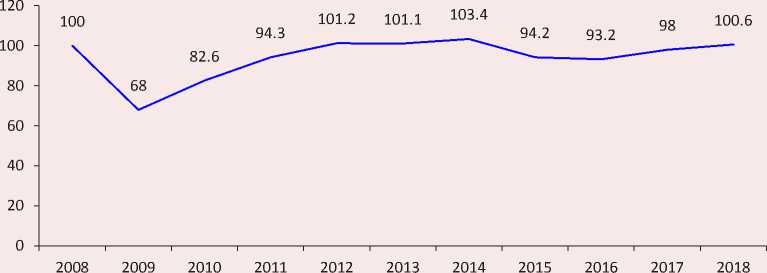
Source: own calculations with the use of Rosstat data.
economic crisis. Thus, according to the calculations of experts from IEF RAS, in 2018, its contribution to the dynamics of industrial production was 0.1% against 65% of the raw material sector [21]. This structural imbalance is reflected in the economic growth of the country as a whole. Judging by the dynamics of the development of Russian mechanical engineering in recent years (Fig. 1) , it is premature to talk about its steady growth, and therefore, a positive impact on the process of structural changes in the country’s economy.
We can identify a number of factors that hinder the development of the machinebuilding industry; these factors include the use of outdated equipment, which is the cause of low quality of products and, as a result, its lack of competitiveness, as well as acute underinvestment and lack of qualified personnel [22; 23]. Meanwhile, mechanical engineering is the basic branch of the entire economy, leading to innovative development, which is one of the factors in the country’s competitiveness on the world stage.
The validity of considering the ICT sector as a driver of economic growth is due to its specific features, which consist in the contradiction between the accelerated development of such technologies and their rapid “moral and physical obsolescence” that stimulate demand for new products [24].
The contribution of this sector to the Russian economy, despite the prospects for its development in terms of modernization of existing industries and the emergence of new ones, is not great.
Thus, in 2017, its share in the economy amounted to 3% of GDP or 2.5 trillion rubles, which is significantly less than in developed foreign countries [9] (Fig. 2).
The analysis of scientific papers on the impact of the information and communication technologies sector on the economy has shown the prospects of its development for the purpose of structural changes. Thus, the study based on input–output tables determined that this sector contributes to the restructuring of the Japanese economy [25]. Other authors used the analysis performed on the example of 159 countries for the period from 2000 to 2009 and revealed a positive relationship between the growth rate of real GDP per capita and the index of ICT use [26].
Figure 2. Contribution of the information and communication technology sector to GDP in 2017, as a % of the total
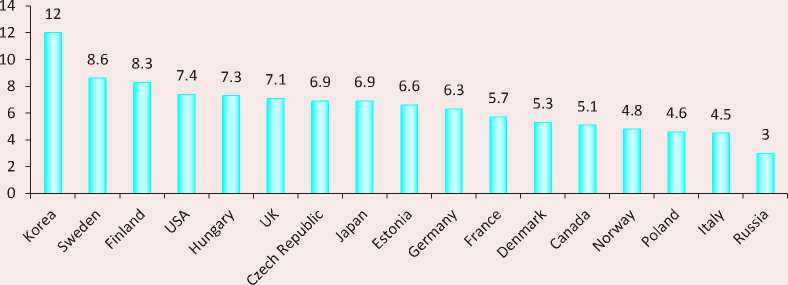
Source: Russia: from digitalization to digital economy. Available at: http://stolypin.institute/wp-content/uploads/2018/09/
The Center for Macroeconomic Analysis and Short-Term Forecasting of IEF RAS made a forecast of the contribution of the ICT sector to Russia’s GDP growth in 2018–2030, which showed that digitalization can provide conditions for almost half of the GDP growth in the target scenario [27].
Although a number of indicators point to strengthening of the processes of digitilization in Russia (wide spread of the Internet, implementation of digital projects initiated by the state), there are a number of obstacles to the more tangible impact of ICT on the economy: the low share of employment in producing information services, government’s barriers to the activities of private companies engaged in the sector.
At the same time, according to experts [9], the development of the ICT sector has a great potential associated with the growth of the number of people employed in it, an increase in the number of digital projects on the part of the state, and an increase in the share of business in the Russian IT industry market.
The potential of tourism development for Russia’s economy and its regions lies in the fact that this sector is one of the most important areas that stimulate domestic consumer demand [20] and eliminate structural imbalances [28].
At the same time, despite the growth of the main indicators of the functioning of Russian tourism in the segment of catering and accommodation (Tab. 1) , its economic effect is not fully manifested.
Table 1. Indicators of tourism development in Russia
|
Indicator |
2011 |
2012 |
2013 |
2014 |
2015 |
2016 |
2017 |
2018 |
2018 to 2011, % |
|
Number of collective accommodation facilities |
12585 |
13062 |
14019 |
14583 |
15590 |
20135 |
20534 |
28072 |
223.1 |
|
Number of persons provided with accomodation, thousand people |
34746 |
37399 |
41065 |
42635 |
44219 |
49284 |
54431 |
73694 |
212.1 |
|
Number of restaurants, cafes, bars |
63505 |
66462 |
70275 |
76367 |
78661 |
80601 |
82429 |
85408 |
134.5 |
|
Number of places in them, thousand units |
3359.7 |
3588.6 |
3832.4 |
4169.9 |
4306.2 |
4360.4 |
4388.0 |
4534.1 |
135.0 |
|
Source: own calculations with the use of Rosstat data. |
|||||||||
Figure 3. The share of gross added value of the tourism industry in the gross domestic product of the Russian Federation, in %

Source: Rosstat data.
Figure 3 shows the contribution of tourism to Russia’s gross domestic product. In 2017, its share in the structure of the Russian economy was 3.8% (for comparison: in China – 11%; in France – 9.5%; in the United States – 7.8%5). However, we should note that cross-country comparisons for this indicator are approximate due to the lack of a common methodology for its calculation.
However, it seems to us that the contribution of the gross added value of tourism to Russia’s economy may be much higher, given the fact that the tourist mobility of residents within the country is extremely weak. This is confirmed by the results of sociological surveys conducted by VTsIOM, according to which on average less than half of Russian residents travel around the country during summer holidays (Tab. 2) .
Table 2. Places where Russians go on holiday in the period of summer vacation
|
Answer |
2010 |
2011 |
2012 |
2013 |
2014 |
2015 |
2016 |
2017 |
2018 |
2019 |
|
At home |
55 |
56 |
48 |
45 |
46 |
40 |
45 |
47 |
45 |
44 |
|
At my dacha, at my private subsidiary plot |
19 |
19 |
25 |
22 |
22 |
26 |
35 |
29 |
34 |
26 |
|
In another Russian city or village |
9 |
9 |
9 |
11 |
4 |
11 |
9 |
12 |
14 |
9 |
|
On the Black Sea coast of the Caucasus (Sochi, Tuapse, Anapa, etc.) |
10 |
8 |
10 |
10 |
9 |
10 |
8 |
11 |
12 |
9 |
|
In the Crimea |
2 |
2 |
2 |
2 |
9 |
7 |
8 |
10 |
9 |
6 |
|
Abroad (outside the former USSR) |
5 |
5 |
8 |
9 |
6 |
6 |
3 |
6 |
4 |
10 |
|
In other places on the territory of the former USSR (except the Baltic States) |
2 |
2 |
2 |
2 |
1 |
1 |
1 |
2 |
3 |
2 |
|
in the Baltic States |
0 |
0 |
0 |
1 |
0 |
0 |
0 |
1 |
1 |
1 |
|
I find it difficult to answer |
7 |
6 |
5 |
6 |
5 |
8 |
6 |
4 |
4 |
4 |
Source: Summer 2019: vacation plans and preferences of Russians. VTsIOM. Available at:
Moreover, the tendency of the majority of Russians to spend their holidays without leaving the borders of their permanent residence is quite stable and does not virtually change over time: over the past seven years, the share of such respondents has varied slightly – in the range from 44 to 48%.
The potential for the development of the sector is seen in increasing domestic tourist consumption, and primarily through the activation of domestic tourism. Thus, in the Strategy for Tourism Development in the Russian Federation until 2035, one of the targets is a twofold increase in the number of trips made within the country, per resident. In addition, the reserves for increasing the contribution of tourism to the economy in the context of structural changes are to increase the availability of tourist services for the population and for certain categories (children, pensioners, older persons, large families, etc.).
The priority of development of the considered sectors-drivers for the Russian economy is enshrined in strategic documents and development programs. Thus, the state program of the Russian Federation “Development of industry and increase of its competitiveness”6 includes the growth rate of the industrial production index of the machine-building industry until 2020, which can be used to assess its dynamics in the medium term.
In the passport of the national project “Digital economy”7 it is planned to increase internal expenditures in GDP for the development of the digital economy from 1.7% in 2018 to 5.1% by 2024.
The Strategy for Tourism Development in the Russian Federation until 20358 states that the contribution of tourism to the country’s GDP in comparison with the level of 2017 should increase by 5.1 times.
The targets for the sectors under consideration have allowed us to calculate the average annual rate of their growth and determine the dynamics of their development for the period up to 2024, i.e. by the time when the Russian economy should become one of the top five in the world. The results of the calculations are presented in Table 3 .
The obtained forecast shows that by 2024, with the set growth rate, the ICT sector should grow the most among the considered industries – by 2.7 times.
The implementation of measures for the development of mechanical engineering, ICT and tourism will contribute to the growth of demand for their products, which is laid down in the framework of the above forecast growth rate of the sectors.
Table 3. Forecast growth rates of engineering, ICT and tourism in Russia in 2018–2024
|
Sector |
Average annual growth, in % |
2018 to 2024, fold |
|
ICT |
118 |
2.7 |
|
Tourism |
111 |
1.9 |
|
Machine building |
104 |
1.3 |
|
Source: own calculations. |
||
6 On approval of the state program of the Russian Federation “Development of industry and increasing its competitiveness”: Resolution of the RF Government dated 15 April 2014 no. 328.
7 Passport of the national program “Digital economy of the Russian Federation”: approved by the Presidium of the Council under the President of the Russian Federation for Strategic Development and National Projects, December 24, 2018 No. 16
8 The Strategy for Tourism Development in Russia until 2035: approved by the Resolution of the Government of the Russian Federation of September 20, 2019 No. 2129-r.
The calculations carried out on the basis of the formed inter-industry model allowed us to determine the importance of stimulating these industries for the economy of Russia and its regions.
In particular, it is revealed that six years of active stimulation of engineering, ICT and tourism sectors will provide additional GDP growth of 4.1 %, and its annual growth only from their development will be 0.7%.
Gross output in the economy as a whole for 2018–2024 will increase by 4.7%, including: tourism – by 2.4 times, mechanical engineering – by 16.1%, the ICT sector – by 2.4% (Tab. 4).
The growth of demand for the products of these sectors will require an increase in the number of employees and the wage fund. According to calculations, the additional increase in the number of employees will be 1,868 thousand people, in the wage fund – 864 billion rubles.
Despite the positive effect on the economy caused by the stimulation of these areas, it is noteworthy that the effect of the activation of mechanical engineering and the information and communication technologies sector in comparison with the tourism industry is not so pronounced. The reason for this lies in the fact that in the formation of the resources of the
Table 4. Effect from the stimulation of mechanical engineering, ICT sector and tourism for the Russian economy
Thus, further stimulation of these industries will develop not the domestic economy, but the national economy of the importing countries, which calls into question Russia’s transition to high-tech development.
According to our calculations, the use of only domestic equipment in the ICT sector will further ensure GDP growth of 0.08%. In this case, in the economy as a whole, gross output will increase by 0.13%, the number of employees – by 0.12%, and the wage fund – by 0.11%.
The tools we used made it possible to identify the distribution of the effect of stimulating these industries in the territorial context. In particular, the increase in output in the context of federal districts was calculated (Fig. 4) .
According to the results of calculations, the Central Federal District will feel the greatest effect of stimulating engineering, ICT and tourism; this fact is quite expected and is explained by the location of the federal city of Moscow, which is the center of attraction for both domestic and inbound tourists,
Figure 4. Increase in gross output due to the stimulation of consumption of goods and services of mechanical engineering, ICT and tourism (total) in the context of federal districts, billion rubles
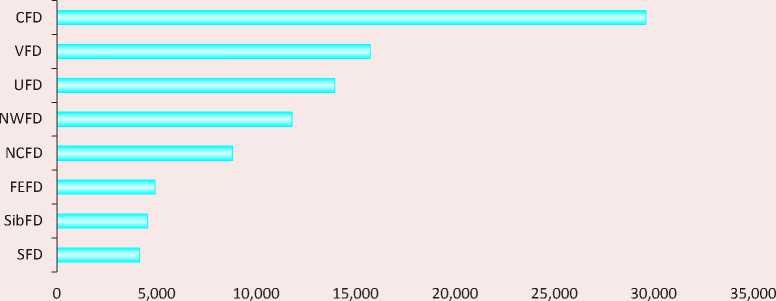
Source: own calculation.
Figure 5. Territorial distribution of the effect of stimulating tourism in the Russian Federation, in % to the total
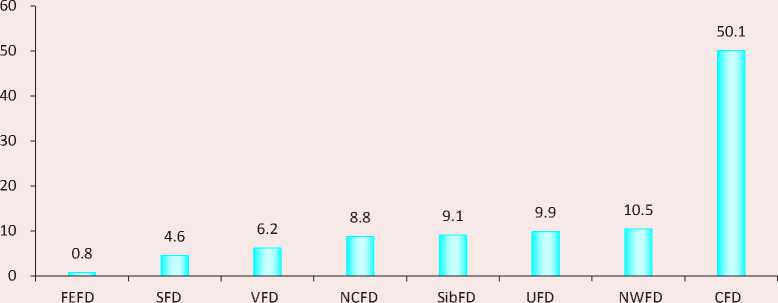
Source: own calculation.
as well as the leader in the development of communications and information technologies in Russia. Due to this, this district is significantly ahead of the rest of the territory. So, the lag of its nearest neighbor – the Volga Federal District – is almost twice.
Let us analyze in more detail how the effect from the growth of demand for the products of each of the considered sectors will be distributed in the regions. Thus, the increase in the output of the tourism industry will have the greatest effect on the Central Federal District: its share will be 50% (Fig. 5) , while the values of this indictor in the Northwestern Federal District, Ural Federal District, Siberian Federal District and North Caucasian Federal District will be significantly lower. These territories occupy approximately the same position – their share in the industry ranges from 8.8 to 10.5%. This indicates the presence of territorial imbalances in the development of tourism in Russia and the need to create new tourist centers.
We should note that the share of the Far Eastern Federal District in the sector under consideration is quite low – 0.8%, which is probably due to weak tourist activity in this region, which occupies about 40% of the territory of Russia9, despite its high tourist and recreational potential.
As for the stimulation of the machinebuilding sector, it will most significantly affect the Central, Volga and Northwestern federal districts, since these territories are the centers of machine-building in Russia (Fig. 6) . It is worth adding that the leadership of the Central Federal District is not so noticeable in comparison with other federal districts, and this indicates the need to build up the potential of this sector in them. The Southern Federal District, which will account for 0.9%, will have the least effect on the increase in consumption of machine-building products.
According to our calculations, the Central Federal District will have the greatest effect in stimulating the information and communication technology sector – its share will be almost 50% (Fig. 7). However, the Volga and Northwestern federal districts have a similar share in this sector – about 12–13%. This indicates the potential of the Russian regions
Figure 6. Territorial distribution of the effect of stimulating mechanical engineering in the Russian Federation, in % to the total
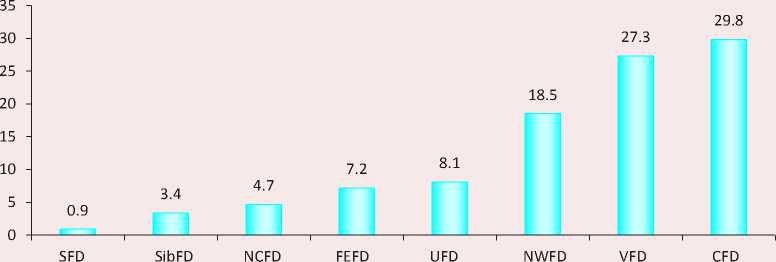
Source: own calculation.
Figure 7. Territorial distribution of the effect of stimulating the ICT sector in the Russian Federation, in % to the total
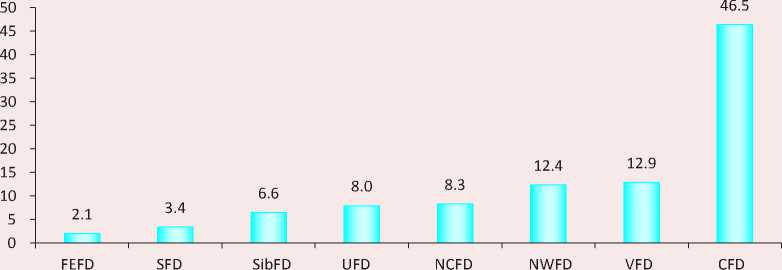
Source: own calculation.
in the process of creating added value generated from the products of the digital industry. At the same time, the Far Eastern Federal District with a share of 2.1% will again become an outsider, as well as in the case of distribution of the effect of increasing demand for products and services in the tourism sector (0.8%).
Thus, the assessment of the distribution of the effect across Russia and in the territorial context has led to the conclusion that it is important for Russia’s economy to stimulate the industries that are considered as drivers of economic growth.
The study made it possible to draw the following conclusions.
-
1. Stimulating industries such as engineering, ICT and tourism contributes positively to Russia’s GDP growth rate. An increase in demand for the products of only these three industries in 2018–2024 further promotes economic growth by 4.1%. At the same time, it is worth considering that a significant problem in this process is the predominance of foreign-made products in the mechanical engineering and in the digital industry. It seems that creating conditions for the production of high-
- quality domestic equipment will help further increase the contribution of these sectors to the economy.
-
2. The results of our cross-industry modeling allowed us to evaluate the effect of stimulating driver industries in the spatial aspect. The observed significant territorial imbalances in the direction of the Central Federal District, which will receive the greatest effect from the projected growth in demand for engineering products, the ICT sector and tourism, dictate the need for more rational and effective development of the remaining territories, taking into account their specifics.
-
3. In order to boost the demand for goods and services produced by the driver industries under consideration it is necessary to implement the set of measures aimed to remove barriers to their development; it is possible through the formation of additional consumer demand for domestic products (engineering and ICT), embedding in the interregional production process chain (for mechanical engineering), higher consumption and investment attractiveness of the tourism industry.
-
4. The formation of demand for goods and services in the engineering, ICT and tourism
Increased development of driver industries will make it possible to complicate the structure of the Russian economy in the direction of increasing the share of high-value-added industries producing high-tech products and increasing domestic consumer demand for goods and services.
It is alarming that a number of regions, including the Far Eastern and Southern federal districts, are among the outsiders in terms of the effect generated by the driver industries, which indicates the need to review the policy in terms of balanced development of territories with regard to a more rational investment policy.
sectors requires the necessary level of investment. Sources for strengthening the investment component can be found in the funds generated as a result of the redistribution of income from the export of raw materials, attracting financial resources of the population and the budget, as well as by creating attractive conditions for business investment in these industries.
Summing up, it is worth noting that Russia and its regions have a potential for the development of industries, which must be used to change the existing structural imbalances. At the same time, the task of management bodies should include the implementation of a policy on implementing this potential by creating the necessary technological base, forming an appropriate demand for products and services, taking into account its uneven territorial aspect. The development of the machinebuilding industry, the ICT sector and tourism contributes to the acceleration of GDP growth, improving the efficiency and competitiveness of the economy of Russia and its regions in the long term.
Scientific significance of the study consists in the development of scientific provisions regarding the identification of sectoral drivers of economic growth, the development of methodological tools to assess their impact on the economy of the country and regions on the basis of input-output tables. Practical significance of the study lies in the possibility of using its results by the authorities in determining the directions that ensure structural changes. In the future, it is planned to continue working to determine the correspondence of the parameters of development of these sectors set out in the strategic documents and the results obtained in the study for a deeper understanding of the problems of structural adjustment of the economy.
Список литературы Structural changes in the economy: searching for sectoral drivers of growth
- Strukturnye izmeneniya v rossiiskoi ekonomike i strukturnaya politika: analiticheskii doklad [Structural changes in the Russian economy and structural policy: analytical report]. Under scientific supervision of E.G. Yasin. Moscow, 2018. 252 p.
- Drobyshevskii S.M., Idrisov G.I., Kaukin A.S., Pavlov P.N., Sinel'nikov-Murylev S.G. Decomposition of growth rates of the Russian economy in 2007-2017 and a forecast for 2018-2020. Voprosy ekonomiki=Economic Issues, 2018, no. 9, pp. 5-31. (In Russian).
- Sukharev O.S. Structural dynamics of Russia's economy: toward a new growth model. Voprosy territorial'nogo razvitiya=Territorial Development Issues, 2016, no. 4 (34). Available at: http://vtr.isert-ran.ru/article/1975. (In Russian).
- Zamaraev V., Marshova T. Investment processes and structural transformation of the Russian economy. Voprosy ekonomiki=Economic Issues, 2017, no. 12, pp. 40-62. (In Russian).
- Behun M., Gavurova B., Tkacova A., Kotaskova A. The impact of the manufacturing industry on the economic cycle of European Union Countries. Journal of Competitiveness, 2018, vol. 10, no. 1, pp. 23-39. 10.7441/ joc.2018.01.02 DOI: 10.7441/joc.2018.01.02
- Structural policy in Russia: new conditions and a possible agenda (a report of the HSE). Voprosy ekonomiki=Economic Issues, 2018, no. 6, pp. 5-28. 10.32609/0042-8736-2018-6-5-28. (In Russian).
- DOI: 10.32609/0042-8736-2018-6-5-28.(InRussian)
- Lenchuk E.B. Novaya industrializatsiya kak uslovie formirovaniya novoi modeli ekonomicheskogo rosta. Novaya model' ekonomicheskogo razvitiya Rossii: kontseptsiya formirovaniya i realizatsii [New industrialization as a condition for the formation of a new model of economic growth. A new model of Russia's economic development: the concept of formation and implementation]. Moscow: Gosudarstvennaya Duma, 2016. 320 p.
- Borisov V.N., Pochukaeva O.V., Pochukaev K.G. The role of mechanical engineering in the process of regional economic diversification. Voprosy territorial'nogo razvitiya=Territorial Development Issues, 2018, no. 5 (45). 10.1 5838/tdi.2018.5.45.3. (In Russian).
- DOI: 10.15838/tdi.2018.5.45.3.(InRussian)
- Rossiya: ot tsifrovizatsii k tsifrovoi ekonomike [Russia: from digitalization to digital economy]. Available at: http://stolypin.institute/wp-ontent/uploads/2018/09/issledovanie_tsifrovaya-ekonomika-14-09-18-1.pdf
- Uskova T.V. Problemy ekonomicheskogo rosta territorii [Problems of economic growth of the territory]. Vologda: In-t sots.-ekon. razvitiya territorii RAN, 2013. 170 p.
- Ilyin V.A., Povarova A.I. Problems of regional development as a reflection of the effectiveness of public administration. Ekonomika regiona=Economy of Region, 2014, no. 3 (39), pp. 48-63. (In Russian).
- Kondrat'ev V. The end of globalization or a new stage? Problemy teorii i praktiki upravleniya=Problems of Management Theory and Practice, 2017, no. 12, pp. 6-17. (In Russian).
- Mironov V.V., Konovalova L.D. On the relationship of structural changes and economic growth in the world economy and Russia. Voprosy ekonomiki=Economic Issues, 2019, no. 1, pp. 54-78. https://doi. org/. (In Russian).
- DOI: 10.32609/0042-8736-2019-1-54-78
- Transformatsiya struktury ekonomiki: mekhanizmy i upravlenie: monografiya [Transformation of the structure of the economy: mechanisms and management: monograph]. Under scientific editorship of A.A. Shirov. Moscow: MAKS Press, 2018. 264 p.
- Eicher T.S., Schreiber T. Structural policies and growth: time series evidence from a natural experiment. Journal of Development Economics, 2010, vol. 91, pp. 169-179.
- DOI: 10.1016/j.jdeveco.2009.05.003
- Freire C. Economic diversification: a model of structural economic dynamics and endogenous technological change. Structural Change and Economic Dynamics, 2019, no. 49, pp. 13-28.
- Kucera D., Jiang X. Structural transformation in emerging economies: leading sectors and the balanced growth hypothesis. Oxford Development Studies, 2019, vol. 47, pp. 188-204.
- Gizatullin Kh.N., Garipov F.N., Garipova Z.F. Problems of management of structural transformations in the regional economy. Ekonomika regiona=Economy of Region, 2018, vol. 14, no. 1, pp. 43-52. (In Russian).
- Baranov A.O., Goreev A.V. Assessment of the impact of national projects on the development of the Russian economy using a dynamic input-output model. EKO, 2019, no. 49 (10), pp. 94-114. Available at: http://dx.doi. org/. (In Russian).
- DOI: 10.30680/ECO0131-7652-2019-10-94-114
- Lukin E.V., Leonidova E.G., Sidorov M.A. Boosting domestic demand as a driving force of economic growth (on the example of domestic tourism sphere). Economic and Social Changes: Facts, Trends, Forecast, 2018, vol. 11, no. 4, pp. 125-143.
- DOI: 10.15838/esc.2018.4.58.8
- Shirov A.A., Mikheeva N.A., Gusev M.S., Savchishina K.E. Macroeconomic stabilization and spatial development of the economy. Problemy prognozirovaniya=Studies on Russian Economic Development, 2019, no. 5, pp. 5-15. (In Russian).
- Mel'nikov A.E. The role of mechanical engineering in the economy of the regions of the European North of Russia. In: Sever i Arktika v novoi paradigme mirovogo razvitiya. Luzinskie chteniya - 2016 [The North and the Arctic in the new paradigm of world development. Luzin readings - 2016]. Apatity: IEP KNTs RAN, 2016. Pp. 667-672. (In Russian).
- Topoleva T.N. Sustainable development of machine-building complex in a competitive environment. Ekonomicheskie issledovaniya i razrabotki=Economic Research and Development. Available at: http://edrj.ru/ article/05-02-2018. (In Russian).
- Nosonov A.M. Specifics of the formation and the laws of development of the information services market in Russia. Sovremennye problemy territorial'nogo razvitiya: elektron. zhurn.=Modern Issues of Territorial Development: Electronic Journal, 2017, no. 3
- Zuhdi U., Mori S., Kamegai K. Analyzing the role of ICT sector to the national economic structural changes by decomposition analysis: the case of Indonesia and Japan. Procedia - Social and Behavioral Sciences, 2012, vol. 65, pp. 749-754. Available at:
- DOI: 10.1016/j.sbspro.2012.11.194
- Farhadi M., Ismail R., Fooladi M. Information and communication technology use and economic growth. PLoS ONE, 2012, no. 7 (11). Available at:
- DOI: 10.1371/journal.pone.0048903
- Digitalization of the Russian economy - from tactical tasks to strategic agenda. Available at: http://www.forecast.ru/_ARCHIVE/Presentations/DBelousov/2019-04-01cifro.pdf. (In Russian).
- Massidda C., Etzo I. The determinants of Italian domestic tourism: a panel data analysis. Tourism Management, 2012, no. 33, pp. 603-610.
- The share of import in industrial sectors of Russia. Available at: http://www.vestifinance.ru/infographics/4721 (accessed 06.09.2019). (In Russian).
- Ksenofontova M.Yu., Shirov A.A., Polzikov D.A., Yantovskii A.A. Assessing the multiplicative effects in the Russian economy on the basis of input-output tables. Problemy prognozirovaniya=Studies on Russian Economic Development, 2018, no. 2, pp. 3-13. (In Russian).

